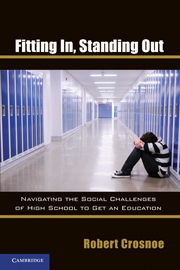Book contents
- Frontmatter
- Contents
- Acknowledgments
- PART I HIGH SCHOOLS AS CONTEXTS OF DEVELOPMENT
- PART II A CASE STUDY OF SOCIAL AND ACADEMIC EXPERIENCES IN HIGH SCHOOL
- PART III HELPING TEENAGERS NAVIGATE HIGH SCHOOL
- 9 Solutions within Schools
- 10 Looking to Parents and Other Adults
- 11 In Search of Theory and Action
- Works Cited
- Index
11 - In Search of Theory and Action
Published online by Cambridge University Press: 05 June 2012
- Frontmatter
- Contents
- Acknowledgments
- PART I HIGH SCHOOLS AS CONTEXTS OF DEVELOPMENT
- PART II A CASE STUDY OF SOCIAL AND ACADEMIC EXPERIENCES IN HIGH SCHOOL
- PART III HELPING TEENAGERS NAVIGATE HIGH SCHOOL
- 9 Solutions within Schools
- 10 Looking to Parents and Other Adults
- 11 In Search of Theory and Action
- Works Cited
- Index
Summary
Several years ago, the filmmaker Michael Moore released an Oscar-winning documentary about the 1999 Columbine High School massacre called Bowling for Columbine. For me, as a developmentalist studying educational policy issues with a focus on peer relations, one of the more thought-provoking parts of this documentary involved an interview with the creator of the television series South Park, Matt Stone, who grew up in Littleton, the affluent Denver suburb in which Columbine was located. Reflecting on his own high school days, Stone discussed his wish that the two boys who had perpetrated the massacre could have just known during high school what they would likely have discovered after high school, what most adults have discovered – that all of those seemingly momentous social struggles and identity crises that go on in high school are temporary, that teenagers eventually grow up, get past all of that stuff, and look back on the things that bothered them, that hurt, and see that none of it matters. His words spoke to me, in part, because I had thought the exact same thing back in April 1999 as I watched the horrific footage from Colorado on the television news. “You just had to wait two years or so,” I thought, “and everything that seems so bad now wouldn't seem so bad anymore.”
- Type
- Chapter
- Information
- Fitting In, Standing OutNavigating the Social Challenges of High School to Get an Education, pp. 241 - 246Publisher: Cambridge University PressPrint publication year: 2011



